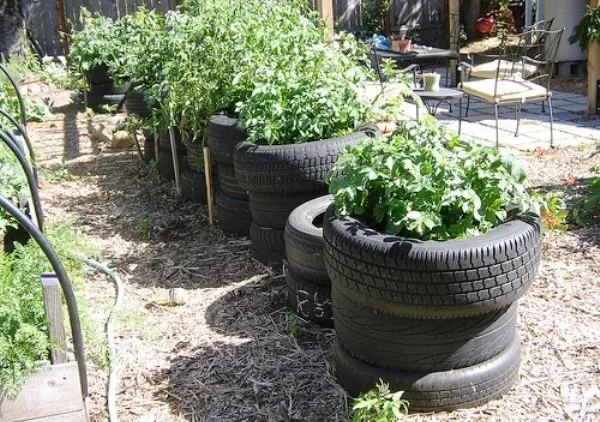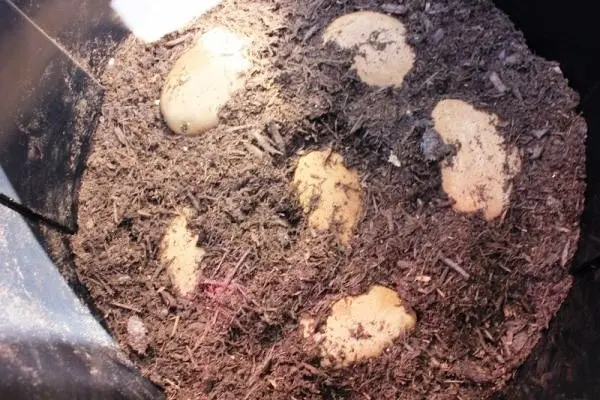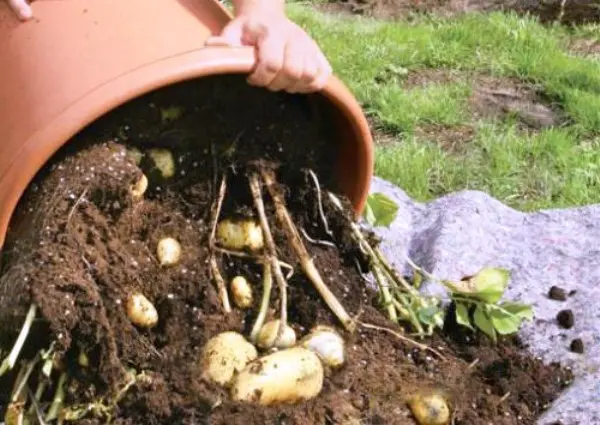Most farmers are accustomed to growing potatoes in garden beds. However, if the site is small, you have to look for alternative ways. One of them is growing potatoes in a barrel. How to build a barrel for planting, the rules for such cultivation and the advantages of the method later in the article.
How to build a landing barrel
Today, the number of supporters of organic cultivation of vegetables and fruits is growing. Incredibly, it turns out that berries and vegetables can be grown in barrels!
There is an opinion that the method of vertical production of potatoes arose by accident: from the legend of a bag of potatoes grown from a single tuber, which inadvertently ended up in a compost pit. For a long time there was no one to test this theory, until experimental organists took it up. And now: the method is tested, improved and adopted.
But in order for the resulting result to please, you should properly build a barrel for vertical cultivation. In fact, there are many ways to make a “house” for potatoes:

- use a regular barrel, removing its bottom. It will need to drill small holes in it (about 1 cm) with an interval of 15 cm;
- use a woven structure. This method is beautiful in that in this design it is not necessary to drill holes, because. they will already be there. Air will safely enter the soil;
- use old car tires;
- use a metal mesh with small cells, wrapping it in advance with straw, which also passes air well.
If you are using a used container, it must be cleaned. This is done as follows: clean the inside of the barrel with a solution of mild bleach or baking soda with boiling water. This will help eliminate pathogens.
So, having learned about the methods of making a container for growing potatoes, you can already proceed directly to planting it.

Growing rules
Such a landing can be divided into several stages:
- First, a small layer of earth (10 cm) is poured into the prepared barrel.
- Sprinkle fertilizer on top. This compost can be a mixture of garden soil, peat moss, grass clippings, or coconut fibers (they are nutritious, inhibit soil compaction, keep roots moist). In fact, in this case there are no special criteria for making compost, so you can use your long-used “recipe”.
- Dip the already sprouted potatoes on an earthen pillow.
- Cover the tubers with good soil. Also about 10 cm. It is important to leave enough space between the tubers so that they are not crowded. There are also two options for planting material: either whole potatoes or cut into pieces can be lowered into the barrel.
This, in principle, is the whole technology of planting potatoes. But separately it is worth mentioning the care of potato barrels.
It is important to always keep the soil moist. After the appearance of the first sprouts, you need to periodically pour new high-quality compost soil into the barrel. Thanks to this, your potatoes will have a lot of tubers, which means a good harvest will come out.

In this regard, it is necessary to establish air access to the lower layers of the earth in the barrel. You should build a small ventilation device. This will require a hose. It is laid in a spiral at the bottom of the container, one edge is hermetically sealed, and the second edge is brought out. Cuts are made along the entire length of the hose, and from time to time air is pumped into the lower layer of the earth using a pump. But, in fact, such measures are necessary only for tightly closed containers, without holes. And if you made small holes over the entire surface of the barrel, as mentioned above, then such procedures are not required.
In the middle of summer, your “bed” will need replenishment of nutrients, so you will need to add top dressing – an infusion of organic matter (an infusion of weeds of dioica nettle and vagrant comfrey). You need to add it 1-2 times a week.
Yellowed and dried tops will serve as an indicator of the readiness of potatoes for harvesting. This will be approximately 8 weeks after the last feeding.
To harvest, turn over and disassemble the barrel. If all procedures are performed correctly, the result will exceed all your expectations.

Advantages
The advantages of using this method are many, and here are some of them:
- such cultivation saves space, especially if you don’t have much of it anyway;
- weeding beds under the scorching sun? Forget! With this method, a vertical bed can be placed in any place convenient for you;
- the Colorado potato beetle and other crop pests like it will not be able to harm. And this means that there is no need to carry out additional measures to eliminate them;
- even late blight will not harm your plants;
- potatoes will not rot, water will not be able to stagnate;
- this method of growing potatoes is a great method of ergonomic disposal of your time and effort.

You can grow potatoes at any time. Want to get new potatoes for Easter? No problem. A special technique will allow you to do this. In March, you need to steam the soil and fill the barrels with it. Barrels close. Stick the germinated planting material through the holes in the barrel, not deep. A couple of weeks the way the barrel “dwells” in the basement. And with the onset of heat, take it out into the yard. Watch carefully that the potatoes do not freeze at night, and the water level in the barrel. You need to water once a month, because at this time of the year the moisture evaporates rather slowly. Harvest after 50 days.
Thus, vertical cultivation of potatoes in a barrel is a modern, environmentally friendly way to obtain a high-quality potato crop. It has a lot of advantages, and is aimed at gardeners with a small plot of land, but a great desire to grow potatoes.
Video “Potatoes in a barrel”
In the video you can see the process of harvesting from a potato bush grown in a barrel.









